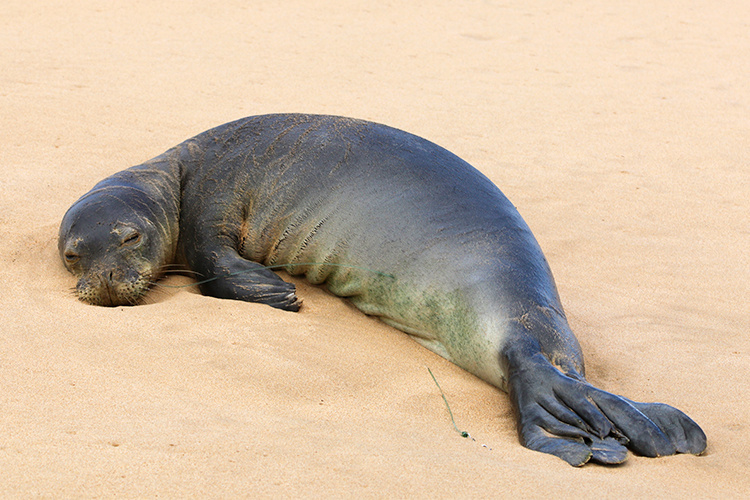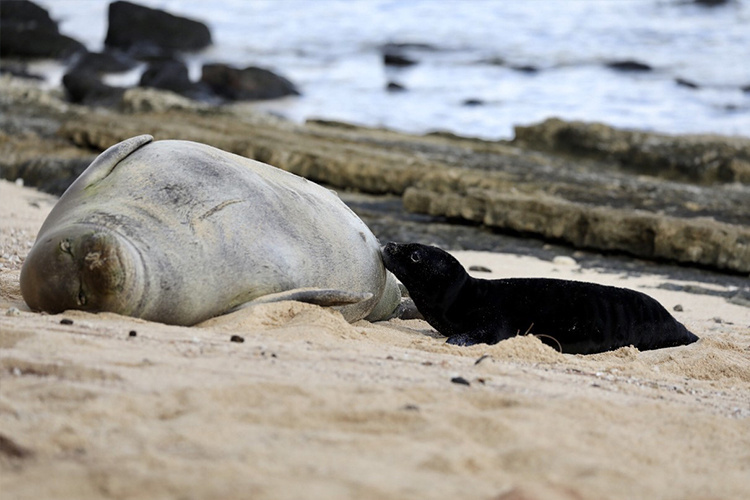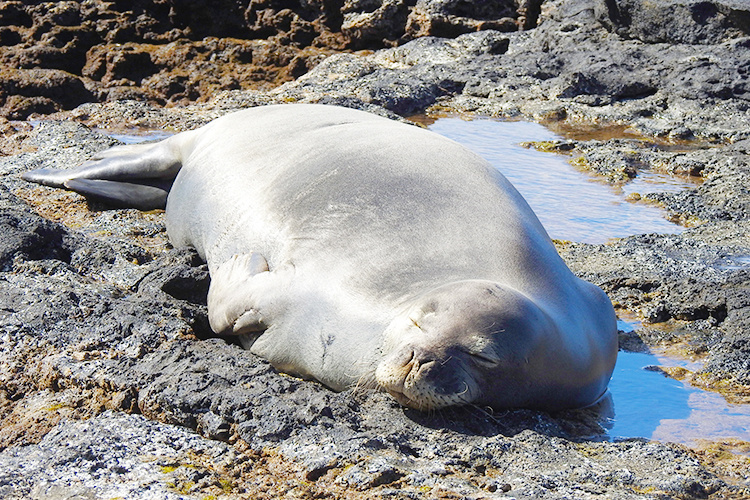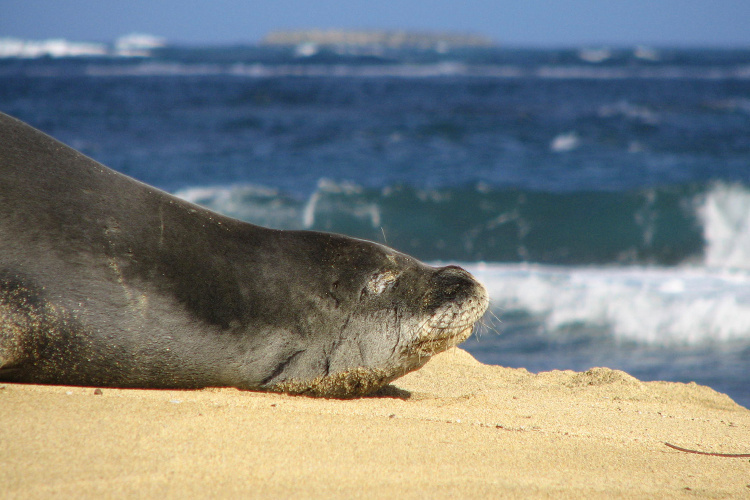Hawaiian Monk Seal Updates 2020
2020 monk seal updates from NOAA Fisheries in the Pacific Islands.
Reward for Information About Recent Kaua'i Seal Deaths
November 24, 2020
You may receive a reward of up to $20,000 if you provide information about a violation that leads to the issuance of a civil penalty or criminal conviction.
The NOAA Fisheries Office of Law Enforcement (OLE) is seeking information about the recent deaths of two Hawaiian monk seals along the shoreline of the Anahola area on the northeast shore of Kauaʻi around September 10 and November 18, 2020.
"The intentional killing of an endangered Hawaiian monk seal is a violation of federal law,” said Assistant Director Martina Sagapolu of OLE’s Pacific Islands Division. “It is our hope that this reward will encourage someone to provide us with the information needed to arrest and convict those who would commit such a heinous act."
OLE is investigating the causes of the two recent deaths on Kauaʻi and has sent enforcement personnel to Kauaʻi to investigate. OLE encourages anyone who may have information about the seal deaths to call the OLE hotline: (800) 853-1964. A reward of up to $20,000 may be paid if you provide information about a violation regarding a monk seal that leads to the issuance of a civil penalty or criminal conviction.
Hawaiian monk seals are protected under the Endangered Species Act of 1973, with about 1,400 estimated alive today. Under the ESA, it is illegal to unlawfully “take,” meaning to harass, harm, pursue, hunt, shoot, wound, kill, trap, capture, or collect, or to attempt to engage in any such conduct with respect to any endangered species or wildlife listed on the Endangered Species List. NOAA Fisheries encourages the public to report all monk seal sightings to its statewide hotline: (888) 256-9840.
The mission of NOAA OLE is to ensure compliance with the laws and regulations enacted to conserve and protect our nation’s marine resources. Those with information about the death of these endangered Hawaiian monk seals should contact the NOAA OLE enforcement hotline at (800) 853-1964.
Back to Top ⤒ | More Information
Yearling Monk Seal Found Dead on Kaua'i
September 16, 2020
NOAA Fisheries is saddened to report the death of RL52, a yearling male monk seal. He was found dead on September 10, 2020, along the Anahola coastline on Kaua‘i. It’s unknown how RL52 died. NOAA’s Office of Law Enforcement (OLE) and DLNR’s Division of Conservation and Resources Enforcement (DOCARE) are currently investigating the matter. RL52 was last seen on August 31, 2020 at North Larsen’s Beach, and he was in good body condition.
If you have any information regarding the death of this seal, please contact DOCARE at (808) 643-DLNR, or use the DLNRTip app. You can also call the OLE hotline at (800) 853-1964.
Please report all monk seal sightings, injuries, and strandings to the Marine Mammal Stranding Hotline at (888) 256-9840.
Back to Top ⤒ | More Information
Monk Seal RJ36 Found Dead with Fishing Line Coming from Mouth
July 15, 2020
Previous: A view from Inside the Kodiak Lab Aquarium

We regret to report the unfortunate death of RJ36, a three-year-old male Hawaiian monk seal on Kauaʻi. On June 22, 2020, a concerned Kauaʻi resident discovered RJ36 in distress. The seal was lying on the beach and appeared to be struggling to breathe. Six feet of fishing line visibly trailed from the mouth and ended in a pigtail swivel, a type of gear commonly used for slide-bait fishing. The concerned citizen immediately contacted the marine mammal stranding hotline. Response staff quickly mobilized, but the seal died before they arrived on scene. The team retrieved the seal's body and NOAA preserved it for a future post-mortem exam.
Ingested hooks can be fatal for some seals, such as if the hook pierces a vital organ. Fortunately, early public reporting of hooked seals often provides response teams with enough time to successfully administer life-saving interventions. A post-mortem exam will evaluate the role the hook and other potential factors played in RJ36’s death.
RJ36 was born to the well-known female RK30 on the Nāpali Coast in 2017. Over the next 3 years, he became a somewhat regular seal on the south and west shores, easily identified by his red J36 and J37 plastic flipper tags.
NOAA and DLNR encourage the public to follow the guidelines for fishing around seals and turtles. These guidelines include watching your fishing gear closely and temporarily removing it if seals are in the area, never feeding seals, and using barbless hooks. If you do hook a seal, cut the line as close to the animal as possible to remove trailing gear. Report it to NOAA’s marine mammal stranding hotline at (888) 256-9840.
Back to Top ⤒ | More Information
Hawaiian Monk Seal 2020 Pupdate
July 1, 2020

The 2020 Hawaiian monk seal pupping season is going by quickly! Since the beginning of the year, 18 monk seal pups were born in the main Hawaiian Islands: 5 on Oʻahu, 11 on Molokaʻi, and 1 each on Kaua‘i and Hawaiʻi Island. This follows a record-breaking pupping year in 2019, which saw 48 pups born in the main Hawaiian Islands (including Ni‘ihau).
While monk seal pups can be born any time of year, the number of births peak in spring and summer. Monk seals moms typically nurse their pups for 5 to 7 weeks, feeding them milk rich in fat that will increase their weight from 30 pounds at birth to nearly 200 pounds! During this time, the mother loses a great amount of weight and will abruptly wean the pup before departing to sea to forage and regain her strength. The pup will live off of its body fat as it practices foraging. It will venture farther and farther from the sands of its birth beach, eventually departing to forage at sea. Most females return to the beaches on which they were born to birth their own pups.


We usually do not disclose pupping locations. This helps maintain a calm environment with as little disturbance as possible to mom-pup pairs. While monk seals aren't typically considered aggressive, a nursing mom can be very protective. For some mom-pup pairs, this year was quieter than usual, due to the closure of various beach parks between late March and mid-May. Despite a reduced monitoring presence, staff and volunteers continued to perform spot checks, and all pups born during this time weaned successfully.
Beaches have been open for several weeks now. We ask members of the public enjoying Hawai‘i shorelines to view wildlife responsibly, keep dogs leashed, and maintain your distance from monk seals, especially moms and pups, for your safety and their protection. We would also like to remind the public to call (888) 256-9840 to report sightings of Hawaiian monk seals or injured marine mammals and sea turtles.
Back to Top ⤒ | More Information
Loss of Pregnant Monk Seal on Kaua'i
May 1, 2020

For the second time in a week, we have to share the unfortunate news that a Hawaiian monk seal has passed away. Pregnant adult female R313 was found dead at Hā'ena Beach, Kaua'i, on April 25, 2020. She was first identified on Kaua'i in 2009 and was at least 15 years old at the time of her death. The lifespan for a Hawaiian monk seal is 25–30 years, though a few individuals have lived longer. The loss of a female seal with many potential breeding years ahead of her is a setback to population recovery of this endangered species.
R313 was never observed with a pup. However, staff and volunteers with NOAA and the Hawai‘i Department of Land and Natural Resources tracked her growing large and appearing pregnant on a number of occasions. She would then leave for about 6–8 weeks and return very thin, as though she had just weaned a pup. We assume that, like many Kaua'i seals, she went to a remote location on Ni'ihau to have her pups.

Our marine mammal and sea turtle stranding network partners have had to make operational decisions based on COVID-19 that impact our ability to respond to strandings and entanglement incidents. We used the fewest number of people possible, followed social distancing protocols, and used personal protective equipment while transporting the carcass to a remote location for burial. As in the case of R5AY (“Honey Girl”), who passed away a few days previously on O'ahu, our ability to conduct the typical post-mortem examinations (including a necropsy) was extremely limited. Adult monk seals, especially pregnant females, can weigh more than 500 pounds and may require a large team for transportation and necropsy.
In R313’s case, however, we were able to preserve her fetus and placenta and will perform necropsy and sampling as soon as it’s feasible. It is possible that this could provide us with additional information related to her cause of death. The most common causes of death in main Hawaiian Islands monk seals include fisheries interactions, trauma, and toxoplasmosis. Based on our limited examination, we cannot rule any of these out at this time. However, if her death was disease related we may be able to determine that from examining her fetus. There were no external signs of trauma such as wounds, but not all trauma is externally visible. There is currently no evidence to support claims that seals, whales, sea lions, or other marine mammals are infected with COVID-19.
The public should continue to report all sightings of stranded animals to the hotline: (888) 256-9840. As always, if you see a stranded monk seal, cetacean, or sea turtle, stay back a safe distance and follow marine wildlife viewing guidelines.
NOAA would like to extend our thanks to the Ocean Safety lifeguards and members of the local community who assisted with the response.
Back to Top ⤒ | More Information
One of O'ahu's Most Well-Known Seals Has Passed Away
April 27, 2020

We are grieving the loss of a very special monk seal today. One of O‘ahu’s most well-known Hawaiian monk seals, R5AY (also known as Honey Girl), was found deceased on the windward side of O‘ahu on April 23, 2020. She was first identified on Kaua‘i in 2002 as an adult. She was at least 23 years old—and perhaps much older—at the time of her death. Honey Girl was frequently sighted and popular with O‘ahu residents, especially in the North Shore and windward communities where she was a long-time resident.
Our marine mammal and sea turtle stranding network partners have had to make operational decisions based on COVID-19 that impact our ability to respond to strandings and entanglement incidents. In order to decrease safety risks to members of the public, including the possibility of attracting sharks to the area or drawing a crowd of onlookers into close proximity with each other, NOAA worked with partners to move the carcass. We used the fewest number of people possible, followed social distancing protocols, and used personal protective gear. We transported Honey Girl to a safe and respectful location at Kualoa Ranch for burial. A Native Hawaiian cultural practitioner performed a pule (blessing) for Honey Girl.
Our ability to conduct the typical post-mortem examinations (including a necropsy) was extremely limited. As a result, our ability to determine Honey Girl’s cause of death is highly constrained. The most common causes of death in main Hawaiian Islands monk seals include fisheries interactions, trauma, and toxoplasmosis. Based on our limited examination, we cannot rule any of these out. There were no external signs of trauma such as wounds, but not all trauma is externally visible. Although blood was observed coming from the nose and mouth, this is not a clear indication of any specific cause of death. Trauma and fisheries interactions, such as entanglement, drowning, or hook ingestion, can affect seals of any age or sex. However, toxoplasmosis primarily affects female seals.
Honey Girl was thought to be pregnant at the time of her death, and at least two seals that have previously died from toxoplasmosis in the past were also pregnant. She had successfully given birth to many pups, so death due to other pregnancy complications is unlikely. Despite her age, Honey Girl was in excellent nutritional condition, and we do not have any information to suggest her health was failing because she was at the end of her life. There is currently no evidence to support claims that seals, whales, sea lions, or other marine mammals are infected with COVID-19.
Honey Girl frequented both O‘ahu and Kaua‘i the first few years after she was initially spotted. After 2005, she spent the vast majority of her time on the shores of O‘ahu, though she was sighted once on Moloka‘i in 2017. In 2012, she was rescued and rehabilitated because a fishing line entanglement caused deep lacerations and infection in her tongue. She was severely emaciated by the time she was caught, and she had a blanket of algae growing on her fur. Veterinarians performed surgery to remove almost half of her damaged tongue, and she was rehabilitated briefly at the Waikīkī Aquarium. She was released back into the wild and went on to give birth to five more pups in her lifetime.
She gave birth to a total of 12 pups between 2005 and 2019, two of which went on to have successful pups of their own. Although only two of her offspring are known to be alive today (RA20 and RK80), her legacy continues on through her grand-pups. Learn more about Honey Girl in this Monk Seal of the Month feature story from 2017.
More Information
Viewing Marine Life
Watching marine animals in their natural habitat can be a positive way to promote conservation and respect for animals and their environment.















